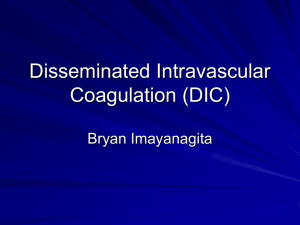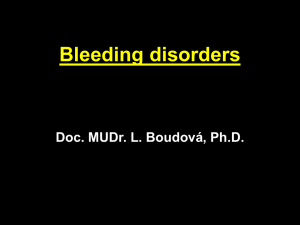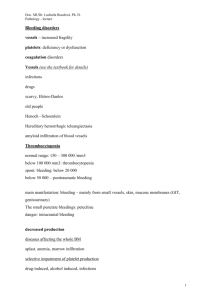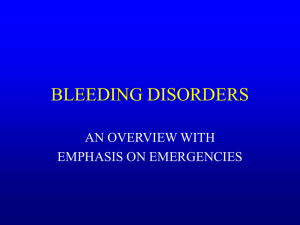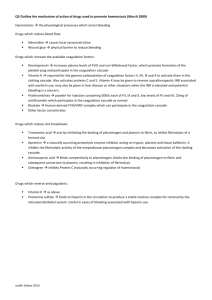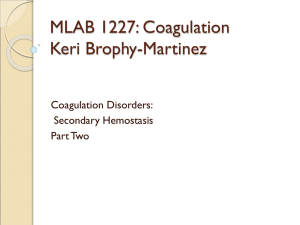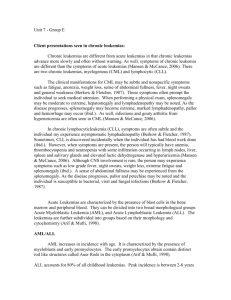10-Disseminated intravascular coagulationppt
advertisement
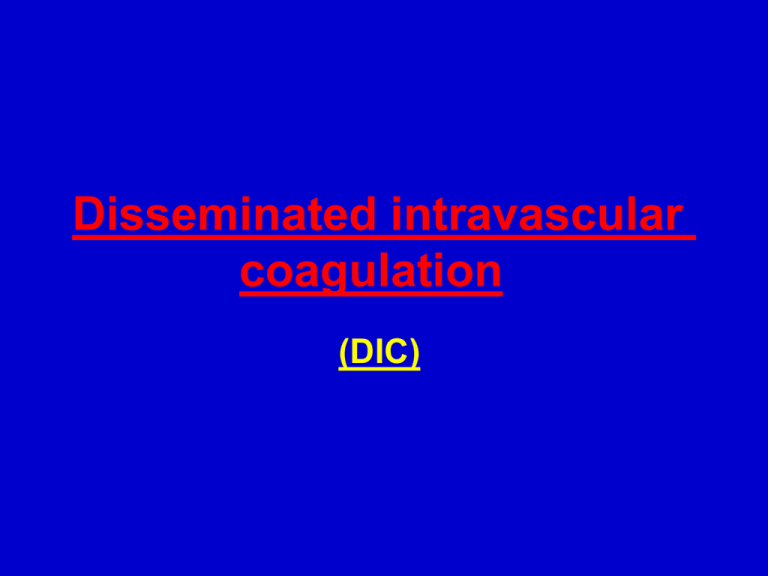
Disseminated intravascular coagulation (DIC) (defibrination syndrome) It is a consumptive coagulopathy that is caused by a wide variety of serious disorders. Etiology * Infections --- G-ve bacterial sepsis --- Other bacteria, fungi, Rocky Mountain spotted fever, viruses, malaria Obstetric complications --- Amniotic fluid embolism --- Retained dead fetus --- Abruptio placentae --- Toxemia of pregnancy --- Septic abortion Malignancies ---- Pancreatic Ca --- Adenocarcinomas --- Acute promyelocytic leukemia (M3) --- Other neoplasms OTHERS * Liver failure * Acute pancreatitis * Snake venom * ARDS * Blood transfusion reaction Trauma ---- Shock --- Brain injury --- Crush injury --- Burns --- Hypothermia/ Hyperthermia --- Fat embolism, ischemia, hypoxia --- Surgery Vascular disorders --- Giant hemangiomas (KassabachMerritt syndrome) --- Vascular tumors, Aortic aneurysms Pathogenesis It is primarily a thrombotic process although its clinical manifestations may be widespread hemorrhage. The basic trigger irrespective of etiology is entry into the circulation of procoagulant substances activating coagulation factors & platelets leading to disseminated deposition of fibrin-platelet thrombi. In most cases the procoagulant stimulant is tissue factor (a lipoprotein that is not normally exposed to blood), mucin in certain malignancies, proteases in other malignancies, pancreatitis, and envenomation. S&S Asymptomatic --- low grade DIC showing only Lab abnormalities Thrombotic complications --- Trousseau's syndrome --- Gangrene of digits & extremities --- Hemorrhagic necrosis of skin --- Purpura fulminans Bleeding --- most common manifestation in acute cases --- Generalized & widespread --- Characteristically from the cannula site --- oozes from mucosal surfaces & orifices Clinical manifestations of the causative disease Dx PT, aPTT & TT are prolonged Thrombocytopenia, Plasma Fibrinogen ↓ FDPs ↑ (measured by latex agglutination or D-dimer assay) Blood film --- Schistocytes, fragmented RBCs DDx --- Coagulopathy of liver failure --- TTP, HUS ℞ Identify & correct the cause • No treatment --- asymptomatic cases (not ttt lab • manifestations) Hemodynamic support • Blood component therapy --- FFP, platelets, cryoppt • Drugs --- Inhibitors of coagulation & fibrinolysis • Heparin – theoretic benefit (if thrombosis • predominates) -- may exacerbate bleeding • Antifibrinolytics – EACA & tranexamic acid • -- Generally C/I in DIC • -- may be useful in life-threatening • bleeding Thrombotic Thrombocytopenic Purpura (TTP) A rare disease characterized by a clinical triad of severe thrombocytopenia, Microangiopathic hemolytic anemia, & Neurologic abnormalities. Renal involvement proteinuria, hematuria, RBC casts & azotemia that is usually mild & remits on ttt Fever is a prominent feature Pathology involved organs show capillaries & arterioles occluded by hyaline material (platelet thrombi) & fibrin deposit in blood vessel wall. Symptoms typically wax & wane (due to platelet aggregation & disaggregation) Fluctuating neurological abnormalities Association with pregnancy & oral contraceptive Dx anemia, thrombocytopenia & Microangiopathic changes of RBCs (Schistocytes) in the absence of other disorders --- Minimal changes in coagulation tests --- Biopsy Skin, gum, or BM • DDx DIC, HUS, SLE & Evan's syndrome • ℞: Untted pt dies within 3 months • Plasmapheresis --- ttt of choice, cure • 70% --- continued until plat • count becomes normal Chronic & relapsing form is seen in • 10% pts whose plasma contains large multimers of vWF Hemolytic Uremic syndrome (HUS) A disease of infants & children rarely occurs in adults Microangiopathic hemolytic anemia, with mild to moderate thrombocytopenia & NO Neurologic abnormalities Acute renal failure is a prominent feature Severe hypertension is a prominent feature GI S&S – abdominal pain, & diarrhea Also seen in women in postpartum period or on oral contraceptives Also seen in pts with cancer receiving mitomycin or cisplatin chemotherapy Von Willebrand disease AD inheritance The most common bleeding disorder 1-3% of population Mild bleeding tendency after trauma or surgery Bleeding from mucosae Easy bruising Bleeding time prolonged ℞ Cryoppt • Desmopressin • Platelet transfusion • EACA •

